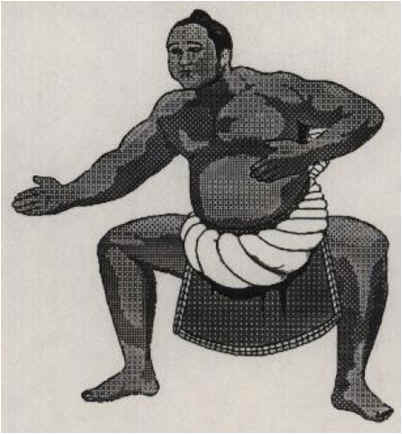
SUMO

|
|
SUMO |
|
Sumo basho (tournaments) are held six times a year during odd-numbered months. The three proper tournaments are held at Kokugikan stadium (the headquarters of the Japan Sumo Association) in Tokyo (January, May and September). The three regional tournaments are held at Osaka prefectural gymnasium in March, Aichi prefectural gymnasium in July, and the Fukuoka International Center in November. Each 15-day tournament usually begins on the second Sunday (Monday in California) of the month and closes on the fourth Sunday.
Common techniques used to win are: hugging the opponent with both arms and
walking him outside of the ring to put him down, push outs, thrust outs,
stepping to either side and pushing the opponent down as he jumps forward,
throws, trips, sweeps, and thrusting to the throat to force the opponent into a
poor position.
After the match, the rikishi bow to one another and the losing rikishi leaves the dohyo. The winning rikishi crouches down and expresses thanks to the three gods of creation by swinging his hand to the north, south, west and east and receives an envelope containing prize money from the referee. Other honors for rikishi ranked below Ozeki (with winningrecords in the tournament) include: awards for Ginosho (Technique), Kantosho (Fighting Spirit), and Shukunsho (Outstanding Performance). Available to everyone, the highest honor is Zensho yusho (best record and perfect—no losses) or Yusho (best record). The rikishi with the best record receives the Emperor's Cup.
Yokozuna (Grand Champion)
Akebono (6' 8", 494 lbs., Hawaiian - the first American Yokozuna)
Ozeki (Champion)
Konishiki (6', 582, Hawaiian)
Wakanohana (5' 10", 260, Takanohana's brother)
Takanohana (6', 315, Wakanohana's brother)
Sekiwake (Sub-Champion)
Musashimaru (6' 3", 412, Hawaiian)
Kotonishiki (5' 9", 300)
Takanonami (6' 4", 351)
Komusubi (Junior Sub-Champion)
Kotonowaka (6' 3", 368)
Akinoshima (5' 8", 313)
Maegashira
| Kushimaumi (#1, 6' 1", 423) | Takatoriki (#1, 5' 11", 318) |
| Tomonohana (#2, 5' 8", 249) | Misugisato (#2, 6', 346) |
| Daishohou (#3, 6' 1", 318) | Takamisugi (#3, 5' 10", 324) |
| Kirishima (#4, 6' 1", 278) | Kenko (#5, 6' 2", 295) |
| Wakashoyo (#5, 5' 11", 364) | Terao (#6, 6' 1", 251) |
| Tochinowaka (#6, 6' 3", 346) | Higonoumi (#7, 6', 302) |
| Kyokudozan (#7, 6', 236) | Kotobeppu (#8, 5' 10", 386) |
| Mainoumi (#8, 5' 7", 216) | Kasugafuji (#9, 5' 9", 318) |
| Kotoinazuma (#9, 5' 11", 291) | Tokitsunada (#10, 6' 2", 406) |
| Daishoyama (#10, 5' 11", 397) | Musoyama (#11, 6', 353) |
| Daizen (#12, 6' 2", 340) | Oginohana (#12, 6' 2", 304) |
| Kiraiho (#13, 6' 2", 340) | Tamakairiki (#13, 6', 318) |
| Toyonoumi (#14, 6' 2", 483) | Kitakachidoki (#14, 6', 329) |
| Minatofuji (#15, 6' 1", 346) | Kaio (#15, 6', 340) |
| Oginishiki (#16, 6' 1", 298) |
JURYO DIVISION
MAKUSHITA DIVISION
SANDANME DIVISION
JONIDAN DIVISION
JONOKUCHI DIVISION
Promotions to Ozeki and Yokozuna are based on the three most recent basho of the candidate. A record of 32 13 (ideally with three consecutive winning records) is about the minimum standard for a successful attempt at Ozeki. Yokozuna promotion requires two consecutive basho championships (or runner-up status) and a record of about 36 9. The Yokozuna Deliberation Council (composed of prominent people from outside sumo) meets to deliberate on the candidate's ability and character. The Council then recommends the candidate for Yokozuna promotion to the Sumo Association, who invariably accept the recommendation.
— { –